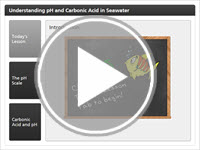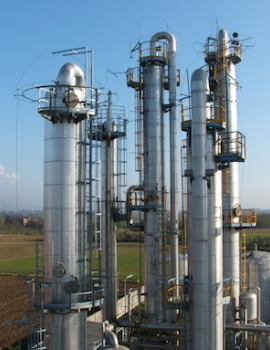
Other Properties of Water
Acidification and Desalination
Understanding pH and Carbonic Acid in Seawater
 In this interactivity, you will examine four topics: What is pH? How is pH measured? What is carbonic acid? and What is buffering? Click the player button to get started.
In this interactivity, you will examine four topics: What is pH? How is pH measured? What is carbonic acid? and What is buffering? Click the player button to get started.
View a printable version of this interactivity.
Acidification of Seawater
The acidity of the oceans has actually increased due to burning large amounts of fossil fuels. Some of the carbon dioxide and other gases released from burning fossil fuels ends up in the oceans. This carbon dioxide dissociates into hydrogen ions and bicarbonate ions that have the potential to increase the acidity of the oceans. An overall increase in the pH of seawater makes it difficult for some organisms to survive.
![]() How does acidification occur? View the video Acid Rain (1:29) from Discovery Education™ streaming about the causes of acid rain and how acidification affects life in bodies of water.
How does acidification occur? View the video Acid Rain (1:29) from Discovery Education™ streaming about the causes of acid rain and how acidification affects life in bodies of water.
Desalination

Industrial Desalination Towers
Luigi Chiesa, Creative Commons
Water is necessary for all living organisms. As the Earth's population increases, so does the need for fresh water. As you know, water covers nearly two-thirds (2/3) of the Earth, with more than 97 percent of this water located in the oceans. This abundance of water may seem to be enough to go around; however, there's a major problem: we can't drink it because it's salty.
The obvious solution is to remove the salt to produce clean, fresh water for drinking and irrigation. This can actually be accomplished through a process called desalination.
![]() Desalination is one of our most ancient technologies! Take a few minutes to learn a few more facts about desalination from the U.S. Geological Survey.
Desalination is one of our most ancient technologies! Take a few minutes to learn a few more facts about desalination from the U.S. Geological Survey.
There are several ways to remove the salt from seawater. Distillation is an ancient method and the simplest. Distilling involves boiling the seawater, collecting the resulting water vapor, and then and condensing the vapor back into pure, liquid water. Freeze separation is another method of desalination. This process freezes the seawater, which when melted, removes most of the dissolved substances from the water. The water is then frozen and thawed multiple times to remove any remaining salts. Reverse osmosis is a third way of removing salt from seawater.
Other Properties of Water Review
![]()
 Now the you have explored the other properties of water, check your knowledge. In this non-graded interactivity, read each statement and determine if it is true or false. Click SUBMIT to check your response. Click the player button to begin.
Now the you have explored the other properties of water, check your knowledge. In this non-graded interactivity, read each statement and determine if it is true or false. Click SUBMIT to check your response. Click the player button to begin.


